The Arts on the Stamps of the World — May 22
An Arts Fuse regular feature: the arts on stamps of the world.
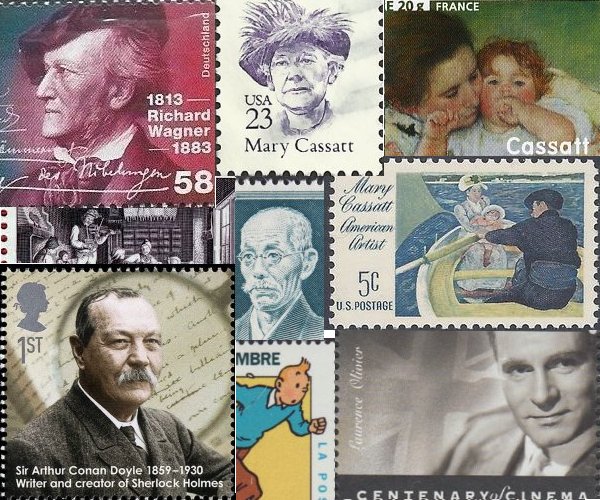
By Doug Briscoe
For May 22nd our primary honorees are Richard Wagner (1813 – 13 February 1883), Mary Cassatt (1844 – June 14, 1926), Sir Arthur Conan Doyle (1859 – 7 July 1930), and Laurence Olivier (1907 – 11 July 1989), Baron Olivier from 1970. In addition to them and numerous others, we celebrate the birthday of Hergé, the creator of Tintin.
In order to contain the overwhelming glut of stamps that deal with today’s subjects, it is painfully necessary for me to discipline myself to no more than two rows of images for each person and the briefest of blurbs. Everybody knows the four headliners I cited above, so I’ll just let the stamps speak for themselves. But you may also need a scorecard: the first collage is Wagner and Cassatt, the second Conan Doyle and Olivier, the third is pure Tintin, the last is a mélange we’ll cross when we come to it.
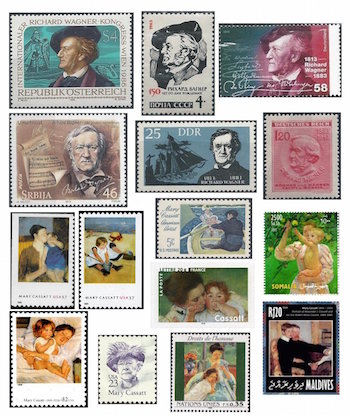
The creator of the internationally known cartoon character Tintin was the Belgian Georges Prosper Remi (1907 – 3 March 1983), known as Hergé. There’s a slewload of Tintin stamps from Belgium, the Netherlands, and France, and one, just one, showing Remi himself. The man was decidedly a bundle of contradictions: he was four times arrested for collaborating with the Nazis (spending a total of one night in jail), despite his having parodied Nazi expansionism in one of Tintin’s adventures, King Ottokar’s Scepter (1938–39), and created the nefarious German Dr. Müller as one of Tintin’s pre-war adversaries; Remi was committed to answering every piece of mail from children fans, which took up a great deal of his time, but he regularly cheated on his wife, which must also have taken up a lot of his time; he was said to have been both affectionate and emotionally distant. Charges of racism, while not entirely unfounded, have been retroactive in accordance with our supposedly more enlightened times. Steven Spielberg’s CGI movie The Adventures of Tintin came out in 2011.
Collage #4, Row 1: Even German sculptor and architect Andreas Schlüter, baptized in Hamburg on 22 May 1664, has at least five stamps commemorating the man and his work. Wikipedia tells us, “His early life is obscure as at least three different persons of that name are documented.” One of his most noted pieces is the equestrian statue (1708) of Frederick William, Elector of Brandenburg, seen in full on the second stamp, with a close-up of the head on the third. The other two depict heads of dying warriors, keystone decorations for the Arsenal in Berlin.
Collage #4, Row 2, Stamp 1. The tricentenary stamp for Austrian painter Daniel Gran (22 May 1694 – 16 April 1757) shows his Allegory of Theology, Jurisprudence, and Medicine, a fresco of whose date and provenance I’m not sure. It may be in the Schwarzenberg Palace in Vienna, but Gran also did work for the Austrian National Library and Klosterneuberg Monastery, among others.
Row 2, Stamp 2. Hubert Robert (1733 – 15 April 1808) was a French painter of fantastic landscapes like Landscape with an Obelisk, Landscape with Ruins, and At the Hermit’s, all of which are shown on a sheet from Saint Vincent that marks the tricentenary of Saint Petersburg’s great Hermitage Museum. Robert is said to have left a thousand paintings and ten thousand drawings. His portrait was painted by Élisabeth Vigée-Lebrun.
Row 2, Stamp 3. Another Frenchman is up next. Gérard de Nerval was born Gérard Labrunie on this date in 1808. His importance in Romanticism lies not only in his own work as a writer, poet, playwright, essayist, and translator, but in introducing the German Romantics Goethe, Schiller, et al. to French readers. (It was his translation of Faust that served as the basis for Berlioz’s opera on the subject.) Robert collaborated with Alexandre Dumas père on a number of plays. His independent work is best represented by his collection Les Filles du feu (The Daughters of Fire, 1854), containing prose pieces, poetry, and a play. Hélas, the overworked and impoverished Nerval suffered nervous breakdowns and hanged himself, still wearing his hat, it seems, on 26 January 1855.
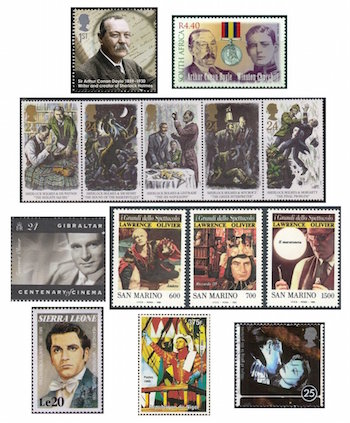
Row 3, Stamps 1 & 2. Born on precisely the same day was another painter, the Hungarian Károly (Charles) Brocky (BROTT-ski), who, curiously, lived only a few months longer than Nerval, expiring on July 8, 1855. On the death of his father, Brocky went off on his own with a troupe of strolling players and somehow wound up at a free drawing school at Vienna. From there he progressed to the École du Louvre at Paris. At about thirty he went to London, where he remained for the rest of his life, exhibiting frequently. The Hungarian stamps give us his Awakening (1850-55) and Venus and Cupid (1850). Between 1839 and 1844 he also made a portrait of Elisabeth Barrett-Browning.
Row 3, Stamp 3. Born six years to the day after Gérard de Nerval and Charles Brocky was the Swedish artist Amalia Lindegren (1814 – 27 December 1891). She was one of only four women accepted to the Royal Swedish Academy of Arts (1849) and the first woman to receive an art scholarship for study in Paris, also learning her craft in Düsseldorf and Münich. She returned to Sweden in 1856. The black and white stamp, issued for the Christmas season of 1971, shows her Sunday Evening in Dalarna (Söndagsafton i en dalastuga, 1860).
Row 3, Stamp 4. Our third consecutive May 22-born painter is Félix Bracquemond (1833 – October 29, 1914), though he is at least as well known for his etchings and decorative work on porcelain, etc. I confess that, insofar as the stamp goes, I’m cheating a bit. While the work of Bracquemond’s wife Marie can be seen on stamps, his own cannot (I guess), so I offer a work by his son Pierre (whose date of birth I can’t narrow down beyond simply 1870 and am thus otherwise prevented from honoring appropriately): Glycines (Wisteria, 1912).
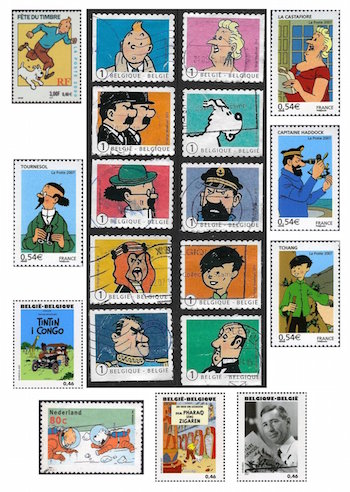
Bottom Row Left. The remarkable Tsubouchi Shoyo (May 22, 1859 – February 28, 1935) helped Japanese readers to a fuller appreciation of Western novels and plays through his criticism (specifically, Shosetsu Shinzui—The Essence of the Novel, 1885) and his translations. He prepared the complete plays of Shakespeare, transformed into the language of kabuki, as well as the novels The Bride of Lammermoor by Walter Scott and Rienzi by Edward Bulwer-Lytton. He also wrote his own plays, both kabuki and modern, and one of the first modern Japanese novels, Tosei Shosei Katagi (Portraits of Contemporary Students, 1885). He used the pen name Harunoya Oboro.
Bottom Row, Stamp 2. Costa Rican composer Julio Fonseca (1885 – 22 June 1950) studied at the Milan Conservatory and in Brussels, returning to his homeland in 1906. He taught theory and harmony and worked as an organist and composer in San José. His works include an operetta, El dinero no es todo, and a children’s opera, Caperucita encarnada, five masses, a Piano Concerto, a Suite and Overture for orchestra, chamber and piano works and songs. He used native melodies in his works and is held as one of the founders of Costa Rican classical music.
Bottom Row, Stamp 3. Like Félix Bracquemond, German artist Rudolf Bergander (1909 – 10 April 1970) worked as a porcelain painter, perhaps not surprising when one learns he was born in Meißen. He joined the Nazi Party in 1940 and served in the Wehrmacht as a mapmaker, but his embrace of Marxist-Leninist ideology after the war made him acceptable enough to the East Germans that they permitted his work Venetian Episode to be shown on a 1967 stamp (during his lifetime). He held a number of prominent positions and received a number of awards.
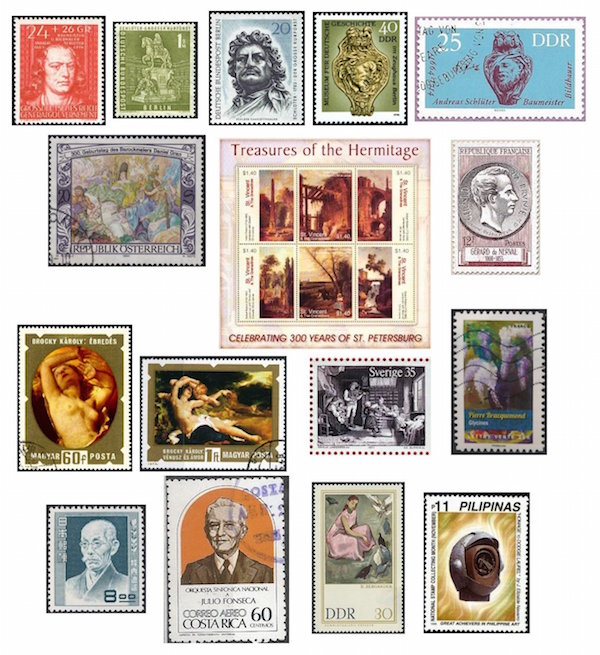
Bottom Row Right. Jerry Navarro Elizalde (22 May 1924 – 10 June 1999) was a Philippine artist who worked as a painter and sculptor. He was married to sculptor Virginia Ty-Navarro (born 1924). On the stamp we see his mixed media composition Homage to Dodgie Laurel (1969).
A graduate of the University of Massachusetts with a B.A. in English, Doug Briscoe worked in Boston classical music radio, at WCRB, WGBH, and WBUR, for about 25 years, beginning in 1977. He has the curious distinction of having succeeded Robert J. Lurtsema twice, first as host of WGBH’s weekday morning classical music program in 1993, then as host of the weekend program when Robert J.’s health failed in 2000. Doug also wrote liner notes for several of the late Gunther Schuller’s GM Recordings releases as well as program notes for the Boston Classical Orchestra. For the past few years he’s been posting a Facebook “blog” of classical music on stamps of the world, which has now been expanded to encompass all the arts for The Arts Fuse.
